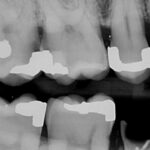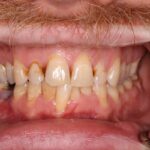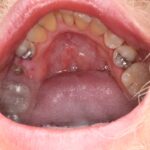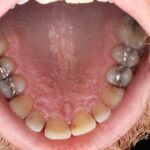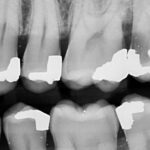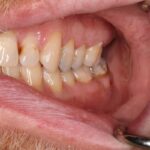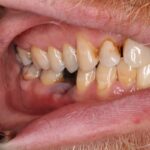What Causes Bone Loss in Teeth?
As the go-to source for dental implants in Portage, MI, our team strives to inform patients about the causes and effects of bone loss. Whether it’s the result of poor oral health, dental trauma, or prior restorative dental work, jawbone loss can be painful to live with and expensive to address.
Dental bone loss occurs when there isn’t sufficient pressure to stimulate bone growth. When you chew, your teeth create pressure as they grind against one another, which can cause extremely minor damage to the underlying bone. When damage occurs, specialized cells work to produce new bone tissue to repair the damage and restore bone density.
However, in some cases, this minor damage never occurs and, therefore, is never repaired or restored by the cells. When this happens, the jawbone deteriorates and bone loss occurs.
Leading Causes of Dental Bone Loss
1. Periodontal Disease
Gingivitis is a form of gum disease that causes swollen gums, tenderness, and inflammation. If left untreated, gingivitis can evolve into periodontitis, which is a much more severe form of gum disease that can cause loose teeth, tooth loss, and the gradual erosion of the jawbone beneath the affected areas.
As of this year, it’s estimated that 42% of Americans over 30 have periodontitis. And, as the top cause of dental bone loss, that’s a frightening statistic. If you notice any symptoms or have any of the risk factors related to periodontal disease, be sure you’re brushing and flossing twice per day and visiting your dentist regularly.
2. Missing Teeth
Healthy teeth create healthy pressure, which helps to stimulate bone growth. But, what happens if you’re missing teeth? Whether they were knocked out due to trauma or extracted due to poor oral hygiene, tooth loss can very easily result in bone deterioration.
If you’ve lost one or more teeth, especially adjacent to one another, it’s important to explore your options. For example, dental implants are a great option to replace missing teeth because they mimic the pressure created by your natural teeth. As a result, they encourage bone growth and preserve the health of your jawbone.
3. Dentures or Dental Bridges
Because they’re fitted above the gumline, dentures and bridges don’t create sufficient pressure to stimulate jawbone growth. And, over time, as the bone continues to deteriorate, the dentures or bridges may become loose, as the foundation that once held them in place has eroded away.
For this reason, dental implants are the most reliable way to address missing or damaged teeth, especially after trauma, tooth extraction, or as a result of underlying health conditions.
4. Misaligned Teeth
As we’ve said, consistent pressure is crucial to the development of a strong, healthy jawbone. If your teeth aren’t properly aligned, though, it can be difficult to create that pressure. To create the right amount of pressure, your teeth require an opposing force. And, just like with missing teeth, misaligned teeth can have ‘voids’ that result in inconsistent or inadequate pressure.
Impacts of Dental Bone Loss
Bone loss of the jawbone can be extremely detrimental to your health. Not only can it lead to a loss of teeth, it often has a whole host of secondary symptoms. From cosmetic changes to your appearance to long-term health problems, it’s best to avoid bone loss by taking steps to ensure good oral health.
1. Gum Recession
An early sign that you may be at risk of bone loss is recession of the gums. When this happens, the tooth root is exposed, which can lead to sensitivity, loose teeth, and painful cavities in the roots of your teeth.
2. Bad Breath
When your gums recede, they create gaps and pockets in your teeth where bacteria can thrive. As the bacteria spreads, they release foul-smelling gases that can result in persistent bad breath.
3. Tooth Loss
Of course, one of the most well-known effects of bone loss is tooth loss. Your jawbone is the foundation that anchors your teeth. It’s what supports them and keeps them fixed in place. But, as your jawbone degrades, it loses its ability to hold your teeth. In time, they become loose. And, without proper treatment, they may begin to fall out.
4. Changes to Facial Structure
Significant bone loss can cause dramatic changes to your facial structure. As you lose more and more bone, the lower half of your face can begin to appear sunken, wrinkled, and aged. In some cases, it can even cause the chin to become pointed and result in asymmetrical features.
5. Jaw Pain
Your jawbone relies on regular pressure to remain strong. Usually accomplished by chewing, this strengthening can be disrupted by missing or misaligned teeth. As a result, your jaw muscles can become overworked, which can cause soreness and chronic pain. And, of course, this pain can make eating difficult, which often results in a painful, self-perpetuating cycle.
How to Treat Bone Loss
Unfortunately, there’s no way to reverse most bone loss. However, there are treatment options to help you mitigate the impact of bone loss and, more importantly, to slow its progression. While bone tissue won’t grow back on its own, there are ways to encourage regeneration in some cases.
1. Scaling and Root Planing
Also called a ‘deep cleaning,’ scaling and root planing removes plaque and tartar from far below the gumline. This can help the gums reattach to the tooth surface and, in some cases, aid in the preservation of your existing bone tissue.
Of course, this treatment option doesn’t restore lost tissue, so more drastic measures may be necessary. However, as an initial treatment for periodontal disease or gum disease, it can help to slow the progression of the disease and preserve your existing bone structure.
2. Bone Graft
In some cases, it is possible to encourage the regeneration of lost bone via a bone graft. During this procedure, new bone is added to the area – or areas – where bone loss has occurred. This addition is often enough to spur new growth and, in effect, restore the affected bone.
After the bone has regenerated, we usually recommend installing a dental implant to ensure that there is enough pressure being created to continue the bone growth and regeneration.
Concerned About Your Oral Health?
At West Wind Dental, we’re steadfastly committed to offering high-quality dental services in Portage, MI. With a full team of experienced, long-term professionals, our practice has grown to offer a wide range of restorative, sedative, preventative, and implant dentistry services.
If you’re concerned about your dental health, we encourage you to reach out to us today. Call us to discuss your concerns, learn about treatment options, and explore the range of options that are available to you.
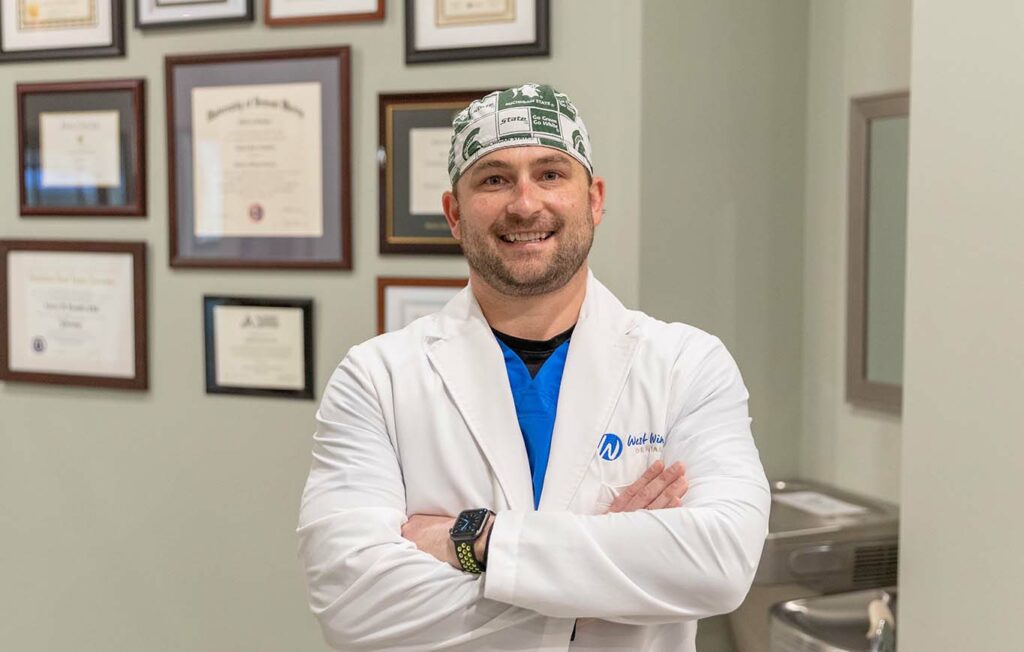
Dr. Andrew Hamilton, DDS, FAGD
Dr. Hamilton is an active member of several professional organizations including the American Dental Association (ADA), the Michigan Dental Association (MDA), the Kalamazoo Valley District Dental Society (KVDDS), the American Academy of Implant dentistry (AAID), the International Academy of Facial Aesthetics (IAFA) and also attends courses with the Pikos Institute in Northwest Florida. He is a member of the International Congress of Oral Implantologists (ICIO), has achieved fellowship status in the International Dental Implant Association (IDIA) and in the Academy of General Dentistry (FAGD), has graduated from and is an alumnus of the Kois Center program in Seattle, and is on the faculty of the Global Dental Implant Academy (GDIA).
The little spare time left over is spent Steelhead and Salmon fishing and the occasional round of golf.

